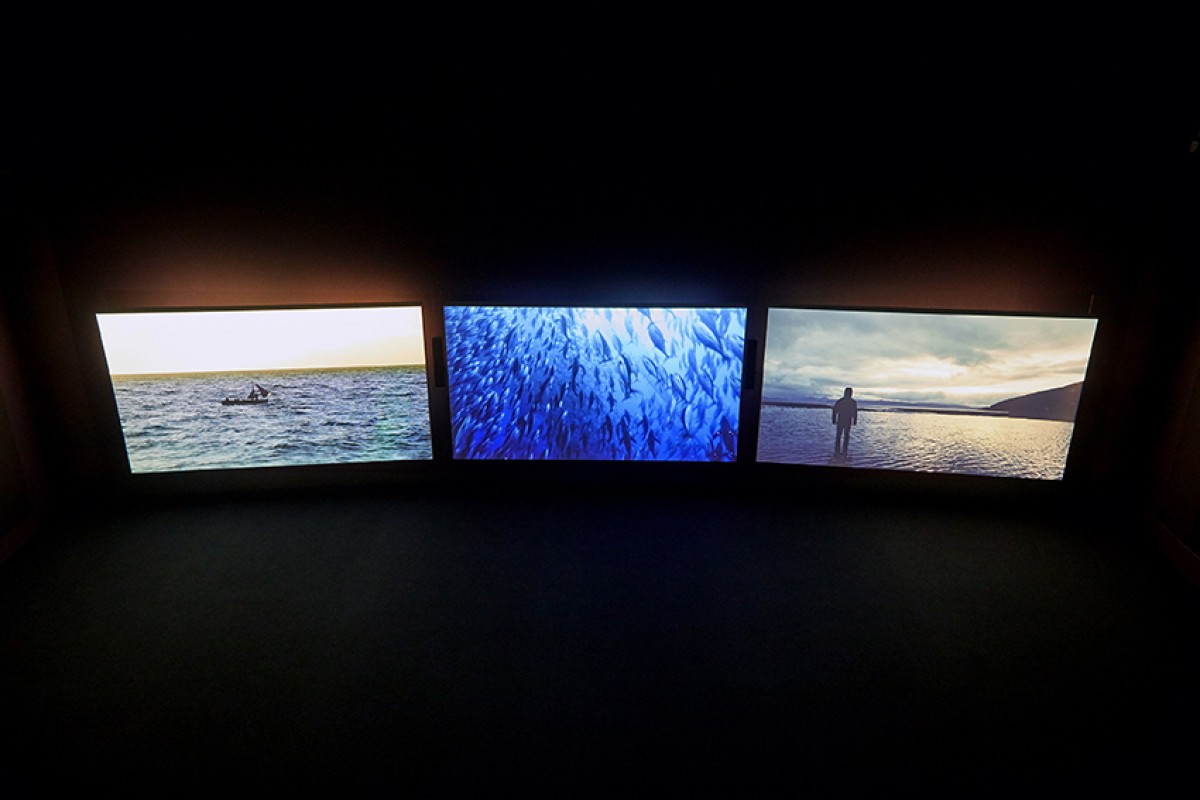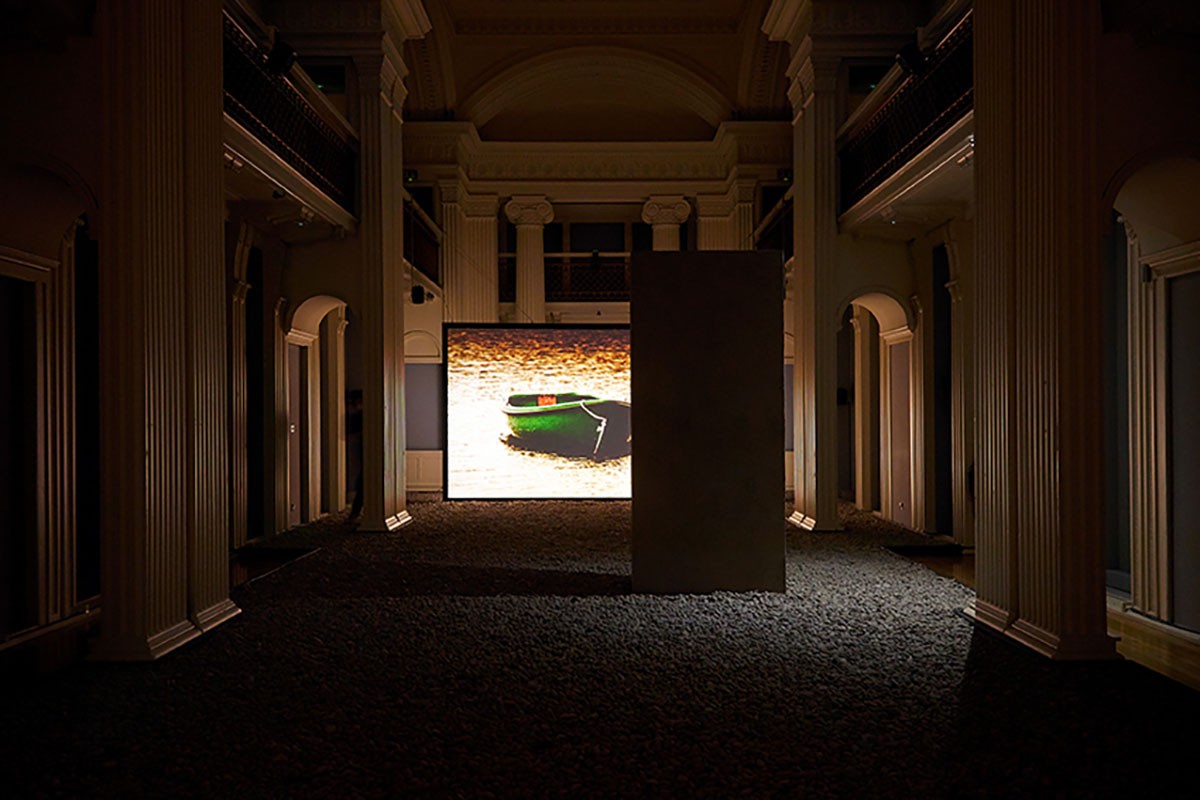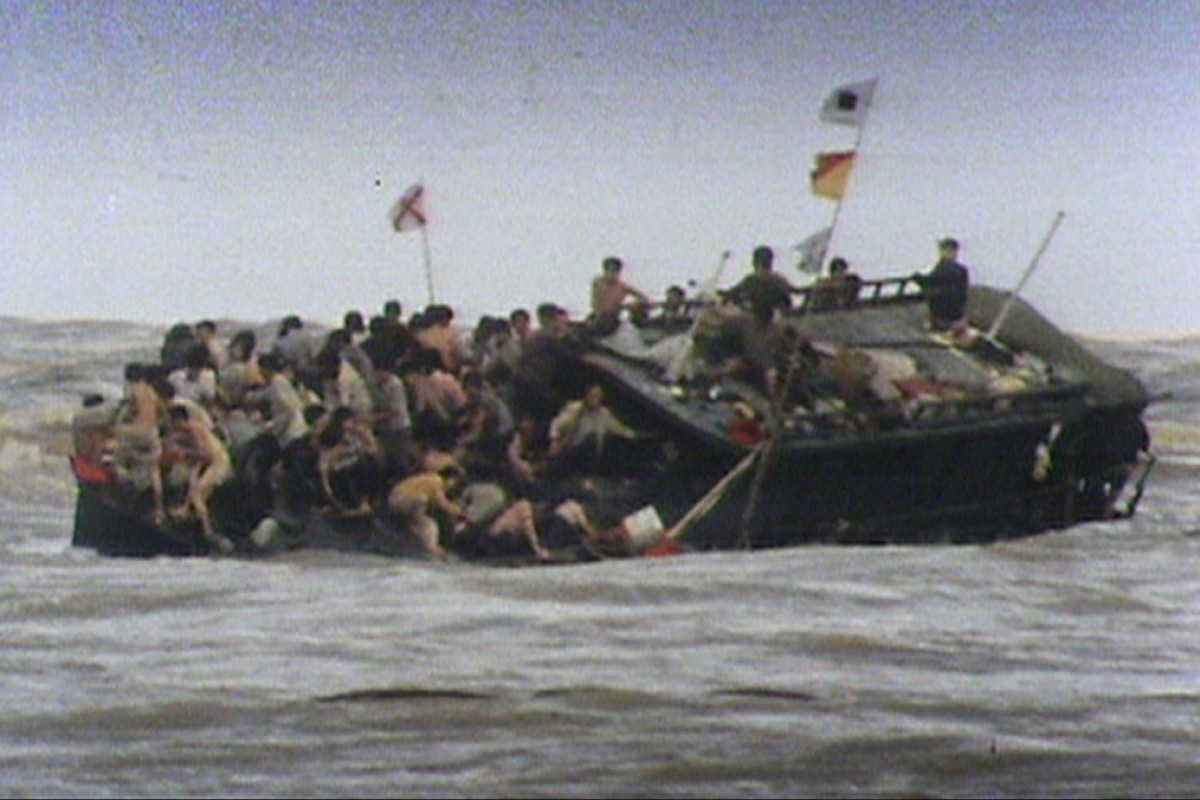John Akomfrah / Vertigo Sea
-

'Vertigo Sea' is the first solo exhibition in Scotland by acclaimed artist and filmmaker John Akomfrah. Read against his formative work with the Black Audio Film Collective (BAFC), the works in the exhibition, ‘At the Graveside of Tarkovsky’ (2012/2017) and ‘Vertigo Sea’ (2015), embody the artist’s long standing engagement with cultural amnesia, global diaspora and individual mortality, and his exploration of the ecological challenges we face today.
Co-founded by Akomfrah in 1982, BAFC grew from the shared concerns of a group of friends who wanted to develop critical discussions around the subject of black identity in Britain whilst combining their artistic interests. In the post-war period, narratives about British identity were deeply problematic – resting on a process that both ‘quarantined’ chapters of history in which black people had played a critical role (including the slave trade and Empire in Africa), and overlooked the longer history of black people living in Britain. Akomfrah would later say that, among those involved in BAFC, ‘there was a sense that we were products of a lacuna, a void.’
The 1981 civil disturbances in Brixton (London), Handsworth (Birmingham), Chapeltown (Leeds) and Toxteth (Liverpool) had forever changed the basis for thinking about ethnicity in Britain, revealing deep rifts in society and the failure of the official portrayal of reality. The BAFC’s response to these events, and their 1985 film ‘Handsworth Songs’, was one of the most important and influential artistic statements made at that time. Mixing archival footage, news footage, fiction, cinematic techniques and an abstract soundtrack, it offered a counter-history that proposed a radically different relationship between the past and the present, questioning notions of truth and unsettling ideas about the stability of identity. The aesthetic and theoretical approach of ‘Handsworth Songs’ established many of the key theoretical and philosophical ideas that would become a hallmark of Akomfrah’s practice and his ongoing negotiation with the past.
Exhibition Guide
Published on the occasion of 'John Akomfrah / Vertigo Sea' at Talbot Rice Gallery, the University of Edinburgh.
Texts are available to view below or download.

GEORGIAN GALLERY
‘At the Graveside of Tarkovsky’ (2012 / 2017). 20 minutes (looped). Mixed media installation with 16 channel ambisonic sound and single channel HD colour video.
Experimental cinema has been one of the most consistent influences in the development of Akomfrah’s aesthetic language and ‘At the Graveside of Tarkovsky’ reflects his debt to the influential Russian director Andrei Tarkovsky. Tarkovsky’s films characteristically fuse subjective and objective representations of history which, it has been argued, has a tendency ‘to disintegrate the conscious self, which calls for a separation of the two.’ This bares resemblance to the ‘thrilling ontological insecurity’, as Kodwo Eshun put it, achieved through Akomfrah’s bricolage in films such as ‘Handsworth Songs’ and ‘Vertigo Sea’. Tarkovsky-esque characters also appear throughout a number of Akomfrah’s works. Like silent witnesses, their external motives remain concealed so that – rather than existing within a separate world of narrative causality, as is common in cinema – they become part of the holistic experience of the meaning of the film. Mirroring them, we are left to witness and question the significance of the filmic environment.
Figures are conspicuously absent from the shorelines of ‘At the Graveside of Tarkovsky’, shot in Skye and Maui (Hawaii). It is the soundtrack that populates the environment with human history through its appropriation of doleful singing, weeping and intonation from Tarkovsky’s films. With the support of the University of Edinburgh’s Sound Design department, Trevor Mathison, a long-term collaborator of Akomfrah, has re-engineered his original composition to create a rich 3-dimensional soundscape. These displaced, homeless sound memories create fleeting presences that are felt but not seen. As Akomfrah found out when visiting Ghana to make a film, many elements of postcolonial history have literally been buried, and an understanding of events can only be structured around gaps and aporias. For Akomfrah, whose parents were political exiles from Ghana, postcolonial and personal history are entwined. His films play with the paradox of having to express the inexpressible, inviting us to consider the agency of the past and imagine the ghosts that return to haunt us. ‘At the Graveside of Tarkovsky’ distils the melancholic elements of his work, where melancholy, according to Linda Tabar, a specialist in post-
Talbot Rice Gallery
colonial studies, ‘is the refusal of closure and the refusal to relinquish a loss [...] a decision to stand in living relationship to what is absent.’ The precarious, somewhat disembodied feeling of walking on pebbles – enhanced by the expanded version of the work created in Talbot Rice’s Georgian Gallery – adds to the kind of subjective and objective disintegration that takes place within this installation; a disintegration shared by graveyards, where people hope to connect their present to the people of the past.

WHITE GALLERY
‘Vertigo Sea’ (2015). 48 minutes. Three channel HD colour video installation, 7.1 sound.
With ‘Vertigo Sea’, Akomfrah sought to explore how questions about diaspora and colonial history could be retooled to face contemporary issues pertaining to migration and the ecological crisis. The result is a remarkable journey across diverse histories, geographies and habitats linked by the sea. This powerful three-screen film is comprised of new footage shot on Skye, the Faroe Islands and Norway, mixed with breath-taking scenes from the BBC Natural History Unit.
Akomfrah was initially moved by a radio interview with Nigerian migrants who survived the perilous crossing of the Mediterranean Sea. Their boat capsized and their only means of survival was to cling onto a tuna fishing net. Akomfrah recalled one of the survivor’s accounts and said that, ‘you could feel how the whole life of this boy changed as he was thrown into the immensity of the sea’. At the time, Akomfrah was appalled by the dehumanisation of migrants in the media, which noxiously referred to them as ‘cockroaches’.
Akomfrah’s research revealed the extent to which the sea has been used as both a literal and metaphorical burial ground. Bodies of National Liberation Front freedom fighters were dumped into the sea during the Algerian revolution, and political prisoners in Pinochet’s Chile met a similar fate. From the 1970s onwards, hundreds of thousands of Vietnamese people fleeing the fallout of the Vietnam War were lost at sea. In parallel with these human tragedies were the natural ones. At its height the whaling industry was responsible for the slaughter of over 50,000 whales per year. These incredible creatures, the largest mammals to ever exist, have been shown to have an almost human intelligence. They carry, as Heathcote Williams imagined in his epic poem Whale Nation, a memory running back millions of years, registering the mysterious soundscapes of the sea. The killing of polar bears, and the testing of nuclear weapons, are all connected in ‘Vertigo Sea’, a film that reflects the enduring beauty and majesty of this incredible, vast, terrifying domain.
Moving back through colonial history, ‘Vertigo Sea’ also references the Zong Massacre, when, in 1781, 133 slaves were thrown overboard so that their slavers could gain insurance money. Iconic in his bright red jacket, Olaudah Equiano (1745–1797) was
a freed slave who helped to raise awareness of this tragedy through his efforts to further the abolitionist cause. Although Equiano’s final resting place is unknown, his posthumously published autobiography contributed to the eventual outlawing of the Slave Trade in 1807. Reflecting upon this autobiography in relation to ‘Vertigo Sea’, cultural critic T.J. Demos has written that, ‘the radical ruptures and ambivalences in Equiano’s life mirror the very incongruities of beauty and terror, fear and attraction, absolute greatness and intense dread, that are often associated with nature and that were conceptualised in the eighteenth century’s philosophical aesthetics of the sublime.’ It is natural then that Equiano appears in ‘Vertigo Sea’ like a romantic character from the work of Caspar David Friedrich, surveying the landscape in front of him.
The literary and philosophical sources referenced in ‘Vertigo Sea’ share this link to Romanticism: with Virginia Woolf’s To The Lighthouse (1921), Friedrich Nietzsche’s Thus Spoke Zarathustra (1891) and Herman Melville’s Moby Dick (1851) all revolving around characters predisposed to introspection. Akomfrah’s ‘Tarkovsky-esque’ characters accompany these other phantom protagonists, surrounded by artefacts from domestic life, cast upon the shore like the remains of a shipwreck. In these scenes – again reminiscent of Romantic paintings – the familiar and homely are set against nature, which takes on the character of some profound ‘other’. Clocks appear repeatedly, their attempt to mechanise time paling in contrast to the crashing, entropic effect of the waves.
‘Vertigo Sea’ is a sensory overload, created by its simultaneous moving images and a soundtrack that includes tragic opera and a melancholic requiem. In it, the filmic sensibility Akomfrah has honed since his work with BAFC and ‘At the Graveside of Tarkovsky’ meets with the present challenges we face in our rapidly changing natural world. Underpinned by tragedy, Akomfrah nevertheless presents us with works that carry a sense of hope. If we embrace diverse histories and open ourselves to the incredible forces of nature, then we can begin to imagine a better future.








